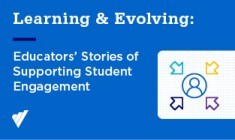The “Learning & Evolving” Series: Educators Share Their Stories on Keeping Students Engaged

Every school is unique, but more than three decades of working closely with schools, educators, and students have taught New Visions for Public Schools that schools face common challenges supporting students’ success during their high school years.
We have also learned that schools working together and learning with each other to address common challenges can accelerate improvement, compared with schools working in isolation.
In 2018, New Visions launched a network of schools called the College Readiness Network for School Improvement (CR NSI), grounded in these learnings. The schools that make up the network are committed to collaborating to increase the number of Black and Latino students prepared to succeed in postsecondary education. Before schools closed down in 2020, many CR NSI schools had identified the strength of relationships between educators and students as a critical lever for improvement, especially for students transitioning from eighth to ninth grade. These schools began implementing structures like advisory programs or identifying point people for individual students, as a way to build relationships more consistently.
Then Covid-19 struck, and educators rapidly had to rethink myriad aspects of their work. Building strong relationships between students and teachers, counselors, and school leaders was more important than ever, but now those relationships needed to be established and sustained in remote contexts.
Changing contexts always have forced creativity and innovation, and the past two years have been no exception. While the resulting shifts have been challenging and exhausting and imperfect, they have catalyzed new practices and learning. During the 2021-22 school year, New Visions has been collaborating with a team from Teachers College, Columbia (TC), to capture the practices and learning from select schools that are part of CR NSI. Bianca Licata, a doctoral student at TC, supported by Professor Thomas Hatch, is leading conversations with educators in these schools to document the different ways they are approaching relationship-building, to help educators learn from each other’s work and to highlight the outstanding work that often goes unseen in schools.
Highlighting the approaches of different schools, the tools and resources schools are creating to support their work, and the lessons they are learning is one way to accelerate improvement across networks of schools, especially when schools are working to address similar challenges and using similar methods. In addition to their shared goal, all of the schools engaged in the CR NSI are committed to using continuous improvement (CI) methods.
New Visions defines CI as an iterative and evidence-based process for improving key systems in schools, year after year, by deeply understanding challenges schools face, generating ideas for how to address these challenges, and testing ideas to identify those that work reliably across different contexts.
This process encourages us to pause before jumping to conclusions and to dig deeper to understand the full range of factors contributing to identified problems. It helps us avoid unintentionally relying on those solutions which are most familiar, whether or not they contribute to improvement against our goals.
Continuous improvement recognizes how non-linear improvement can be. Educators are constantly deepening their understanding of what’s driving student outcomes or school practices. They uncover new challenges. They adapt and try new approaches. They learn what works and doesn’t, under what circumstances and for which students. Ideally, the things that they learn, joined with the resources and routines that they develop, are relevant and applicable beyond their single school; other schools struggling with similar challenges or seeking to improve similar outcomes can accelerate their improvement by adapting what peer schools have done. For this to happen effectively, though, we need to make what schools are learning more visible.
Over the coming months, we hope to do just that. In summer of 2022, we will conclude the series by highlighting key ideas and themes from the stories, along with early thinking about how we build on these lessons as a network.
We hope that the strategies we highlight resonate with educators and school leaders beyond our network. As importantly, we hope that stories of schools striving to adjust to profoundly different circumstances while maintaining a core commitment to student success is inspiring. We have the deepest respect for students, educators, and school communities that have not just endured the past two years but seen the time as a period of change for the better.